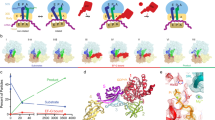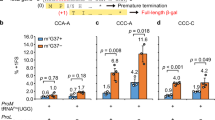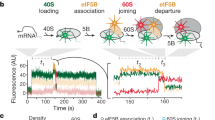Abstract
Two crystal structures of yeast translation elongation factor 2 (eEF2) were determined: the apo form at 2.9 Å resolution and eEF2 in the presence of the translocation inhibitor sordarin at 2.1 Å resolution. The overall conformation of apo eEF2 is similar to that of its prokaryotic homolog elongation factor G (EF-G) in complex with GDP. Upon sordarin binding, the three tRNA-mimicking C-terminal domains undergo substantial conformational changes, while the three N-terminal domains containing the nucleotide-binding site form an almost rigid unit. The conformation of eEF2 in complex with sordarin is entirely different from known conformations observed in crystal structures of EF-G or from cryo-EM studies of EF-G–70S complexes. The domain rearrangements induced by sordarin binding and the highly ordered drug-binding site observed in the eEF2–sordarin structure provide a high-resolution structural basis for the mechanism of sordarin inhibition. The two structures also emphasize the dynamic nature of the ribosomal translocase.
This is a preview of subscription content, access via your institution
Access options
Subscribe to this journal
Receive 12 print issues and online access
$189.00 per year
only $15.75 per issue
Buy this article
- Purchase on Springer Link
- Instant access to full article PDF
Prices may be subject to local taxes which are calculated during checkout




Similar content being viewed by others
References
Semenkov, Y.P., Rodnina, M.V. & Wintermeyer, W. Energetic contribution of tRNA hybrid state formation to translocation catalysis on the ribosome. Nat. Struct. Biol. 7, 1027–1031 (2000).
Noller, H.F., Yusupov, M.M., Yusupova, G.Z., Baucom, A. & Cate, J.H. Translocation of tRNA during protein synthesis. FEBS Lett. 514, 11–16 (2002).
Ramakrishnan, V. Ribosome structure and the mechanism of translation. Cell 108, 557–572 (2002).
Czworkowski, J., Wang, J., Steitz, T.A. & Moore, P.B. The crystal structure of elongation factor G complexed with GDP, at 2.7 Å resolution. EMBO J. 13, 3661–3668 (1994).
Aevarsson, A. et al. Three-dimensional structure of the ribosomal translocase: elongation factor G from Thermus thermophilus. EMBO J. 13, 3669–3677 (1994).
Nissen, P. et al. Crystal structure of the ternary complex of Phe-tRNAPhe, EF-Tu, and a GTP analog. Science 270, 1464–1472 (1995).
Rodnina, M.V., Savelsbergh, A., Katunin, V.I. & Wintermeyer, W. Hydrolysis of GTP by elongation factor G drives tRNA movement on the ribosome. Nature 385, 37–41 (1997).
Katunin, V.I., Savelsbergh, A., Rodnina, M.V. & Wintermeyer, W. Coupling of GTP hydrolysis by elongation factor G to translocation and factor recycling on the ribosome. Biochemistry 41, 12806–12812 (2002).
Czworkowski, J. & Moore, P.B. The conformational properties of elongation factor G and the mechanism of translocation. Biochemistry 36, 10327–10334 (1997).
Agrawal, R.K., Penczek, P., Grassucci, R.A. & Frank, J. Visualization of elongation factor G on the Escherichia coli 70S ribosome: the mechanism of translocation. Proc. Natl. Acad. Sci. USA 95, 6134–6138 (1998).
Stark, H., Rodnina, M.V., Wieden, H.J., van Heel, M. & Wintermeyer, W. Large-scale movement of elongation factor G and extensive conformational change of the ribosome during translocation. Cell 100, 301–309 (2000).
Gomez-Lorenzo, M.G. et al. Three-dimensional cryo-electron microscopy localization of EF2 in the Saccharomyces cerevisiae 80S ribosome at 17.5 Å resolution. EMBO J. 19, 2710–2718 (2000).
Justice, M.C. et al. Elongation factor 2 as a novel target for selective inhibition of fungal protein synthesis. J. Biol. Chem. 273, 3148–3151 (1998).
Dominguez, J.M., Gomez-Lorenzo, M.G. & Martin, J.J. Sordarin inhibits fungal protein synthesis by blocking translocation differently to fusidic acid. J. Biol. Chem. 274, 22423–22427 (1999).
Laurberg, M. et al. Structure of a mutant EF-G reveals domain III and possibly the fusidic acid binding site. J. Mol. Biol. 303, 593–603 (2000).
Kjeldgaard, M., Nissen, P., Thirup, S. & Nyborg, J. The crystal structure of elongation factor EF-Tu from Thermus aquaticus in the GTP conformation. Structure 1, 35–50 (1993).
Andersen, G. et al. Structural basis for nucleotide exchange and competition with tRNA in the yeast elongation factor complex eEF1A:eEF1Bα. Mol. Cell 6, 1261–1266 (2000).
Peske, F., Matassova, N.B., Savelsbergh, A., Rodnina, M.V. & Wintermeyer, W. Conformationally restricted elongation factor G retains GTPase activity but is inactive in translocation on the ribosome. Mol. Cell 6, 501–505 (2000).
Shastry, M. et al. Species-specific inhibition of fungal protein synthesis by sordarin: identification of a sordarin-specificity region in eukaryotic elongation factor 2. Microbiology 147, 383–390 (2001).
Dominguez, J.M. & Martin, J.J. Identification of a putative sordarin binding site in Candida albicans elongation factor 2 by photoaffinity labeling. J. Biol. Chem. 276, 31402–31407 (2001).
Al-Karadaghi, S., Ævarsson, A., Garber, M., Zheltonosova, J. & Liljas, A. The structure of elongation factor G in complex with GDP: conformational flexibility and nucleotide exchange. Structure 4, 555–565 (1996).
Andersen, G.R., Valente, L., Pedersen, L., Kinzy, T.G. & Nyborg, J. Crystal structures of nucleotide exchange intermediates in the eEF1A:eEF1Bα complex. Nat. Struct. Biol. 8, 531–534 (2001).
Roll-Mecak, A., Cao, C., Dever, T.E. & Burley, S.K. X-ray structures of the universal translation initiation factor IF2/eIF5B: conformational changes on GDP and GTP binding. Cell 103, 781–792 (2000).
Polekhina, G. et al. Helix unwinding in the effector region of elongation factor EF-Tu:GDP. Structure 4, 1141–1151 (1996).
Nurten, R. & Bermek, E. Interactions of elongation factor 2 (EF-2) with guanine nucleotides and ribosomes. Binding of periodate-oxidized guanine nucleotides to EF-2. Eur. J. Biochem. 103, 551–555 (1980).
Agrawal, R.K., Heagle, A.B., Penczek, P., Grassucci, R.A. & Frank, J. EF-G-dependent GTP hydrolysis induces translocation accompanied by large conformational changes in the 70S ribosome. Nat. Struct. Biol. 6, 643–647 (1999).
Stark, H. et al. Ribosome interactions of aminoacyl-tRNA and elongation factor Tu in the codon-recognition complex. Nat. Struct. Biol. 9, 849–854 (2002).
Valle, M. et al. Cryo-EM reveals an active role for aminoacyl-tRNA in the accommodation process. EMBO J. 21, 3557–3567 (2002).
Klaholz, B.P. et al. Structure of the Escherichia coli ribosomal termination complex with release factor 2. Nature 421, 90–94 (2003).
Rawat, U.B. et al. A cryo-electron microscopic study of ribosome-bound termination factor RF2. Nature 421, 87–90 (2003).
Vestergaard, B. et al. Bacterial polypeptide release factor RF2 is structurally distinct from eukaryotic eRF1. Mol. Cell 8, 1375–1382 (2001).
Jorgensen, R., Carr-Schmid, A., Ortiz, P.A., Kinzy, T.G. & Andersen, G.R. Purification and crystallization of the yeast elongation factor eEF2. Acta Crystallogr. D 58, 712–715 (2002).
Schneider, T.R. & Sheldrick, G.M. Substructure solution with SHELXD. Acta Crystallogr. D 58, 1772–1779 (2002).
Brunger, A.T. et al. Crystallography & NMR system: a new software suite for macromolecular structure determination. Acta Crystallogr. D 54, 905–921 (1998).
Terwilliger, T.C. Maximum-likelihood density modification. Acta Crystallogr. D 56, 965–972 (2000).
Jones, T.A., Cowan, S., Zou, J.-Y. & Kjeldgaard, M. Improved methods for building protein models in electron density maps and the location of errors in these models. Acta Crystallogr. A 47, 110–119 (1991).
Navaza, J. AMoRe: an automated package for molecular replacement. Acta Crystallogr. A 50, 157–163 (1994).
Laskowski, R., MacArthur, M.W., Mos, D.S. & Thornton, J.M. PROCHECK: a program to check the stereochemical quality of protein structures. J. Appl. Crystallogr. 26, 283–291 (1993).
Hayward, S. & Berendsen, H.J. Systematic analysis of domain motions in proteins from conformational change: new results on citrate synthase and T4 lysozyme. Proteins 30, 144–154 (1998).
Koradi, R., Billeter, M. & Wuthrich, K. MOLMOL: a program for display and analysis of macromolecular structures. J. Mol. Graph. 14, 29–32 (1996).
DeLano, W.L. The PyMOL User's Manual (DeLano Scientific, San Carlos; 2002).
Sprang, S.R. G protein mechanisms: insights from structural analysis. Annu. Rev. Biochem. 66, 639–678 (1997).
Acknowledgements
We gratefully acknowledge access to the coordinates of eEF2-cryo (J. Frank) and the fitted coordinates of three states of EF-G (W. Wintermeyer). We also appreciate fruitful discussions with J. Nyborg. R.J. and G.R.A. were supported by Merck Research Laboratories, the Danish Science Research Council, Dansync and the EU. T.G.K. and P.A.O. were supported by the NIH. P.N., T.G.K. and G.R.A. were supported by the Human Frontiers Science Program.
Author information
Authors and Affiliations
Corresponding author
Ethics declarations
Competing interests
The authors declare no competing financial interests.
Rights and permissions
About this article
Cite this article
Jørgensen, R., Ortiz, P., Carr-Schmid, A. et al. Two crystal structures demonstrate large conformational changes in the eukaryotic ribosomal translocase. Nat Struct Mol Biol 10, 379–385 (2003). https://doi.org/10.1038/nsb923
Received:
Accepted:
Published:
Issue Date:
DOI: https://doi.org/10.1038/nsb923
This article is cited by
-
mRNA reading frame maintenance during eukaryotic ribosome translocation
Nature (2024)
-
Evolutionary and functional relationships in the ribosome biogenesis SBDS and EFL1 protein families
Molecular Genetics and Genomics (2021)
-
Protein kinase A controls yeast growth in visible light
BMC Biology (2020)
-
eEF-2 kinase is a critical regulator of Warburg effect through controlling PP2A-A synthesis
Oncogene (2016)
-
Cryo-EM structure of the yeast U4/U6.U5 tri-snRNP at 3.7 Å resolution
Nature (2016)



